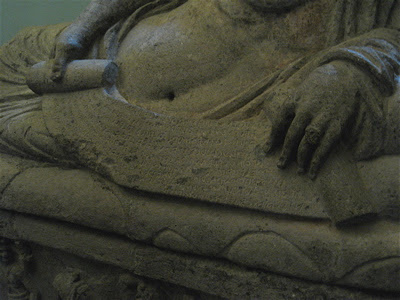If it's Friday, it's most likely field trip day. Today? Another significant Etruscan city, Tarquinia.
Tarquinia, 40 KM SW of Viterbo, is situated on a high ridge a few kilometers from the Tyrrhenian Sea. This vantage point allowed them to be able to watch for attackers as they made their way up from the coast.
Like most towns in Italy of all ages, Tarquinia was and still is a walled city. Here is the Casello entrance.
This beautiful church is currently abandoned. As Italy, and Europe in general, becomes more secular, there simply isn't enough money to keep old churches active. Also, notice the "thin" bell tower atop the church. This style is quite regularly seen in the Viterbo area. Lastly, notice the shadow cast over the building.
It is being caused by one of the many towers in the town. Tarquinia is also a city of towers. These towers, most of them built to serve as lookout in days gone by, are now boarded up. There are 16 towers in the central medieval town of Tarquinia.
Two more towers!
Tarquinia is home to a museum that houses many Etruscan age sarcophagi. The Sarcophagi lids were carved in the likeness of the person buried within. The quality of the sarcophagi lids reached their height around 500-480BC, just before the Etruscans lost the Battle of Cuma and thereby control of the Tyrrhenian. This lead to recession in Etruria.
A female sarcophagus from the 4th century.
"Lars Pulena" a magistrate, according to documents. Notice the figures in the register on the "cassia" itself. The two demons with hammers on each side of Lars indicate he has reached the afterlife.
Lars Pulena (who also shows up Gardner's History of Art text) was sculpted in the 2nd Century BCE. This is a time of decline in Etruria and notice the somber facial expression. This contrasts to the more expressive faces from the Archaic period.
Instead of featuring his wife in repose with him, Lars is seen unrolling a scroll, which tells us of his life accomplishments.
An amphora (narrow neck used to store liquids) is painted in black figure. Italy is the best pace to find Greek Vases because of the significant trade that was happening between the two area. In addition, because Etruscans were buried with goods to take into the afterlife we find a large of number of Greek vases here.
A red figure krater (wide top used to mix liquids, such as alcohol for banquets). Red figure painting is an advancement in artistic form because the painters has to draw "in reverse" as in paint in everything but the items he wants to stand out.
Greek Plate Porn!
Amphora porn (it took me a while to figure out the man is lifting up the woman's skirt)! I guess Etruscans were not self-conscious about letting everyone know about their private interests.
An Etruscan musical instrument.
Eunice S. from Kentucky(Home)/Indiana(School) (left) doesn't want her photo taken and Carryn B. of Colorado/California.
Weston M. of Maine
In the afternoon, we walked to what looked to be a random field, but it turns out to be another Etruscan Necropolis.
These mushroom shaped urns are from the Villanovan (early) period.
These huts are actually modern day constructions that allow us to step down into Etruscan tombs of the 4th century that were excavated into the ground and left unmarked. The Etruscans, remember, buried their dead with gifts and items and didn't want the dead and the goods to be disturbed.
You enter the hut and go down the stairs
At the bottom, you are faced with a dark door and there is anticipation and excitement for what comes when you push the button to turn on the light.
Almost all of the tombs here in Tarquinia are of this double sloped roof with a column down the center of the ceiling. This forms a trapezoidal shaped area called the "tympinum." Shown here (and also featured in Gardner's) is the best preserved, and most vibrantly painted, Tomb of the Leopards.
Like most tombs, the scene painted is one of a dinner gathering with men lying around eating, being attended to by courtesans and served by young men.

The Tomb of the Leopards is dated to 480 BCE, the height of Etruscan life. The quality of the painting is at its height.
Here in this tomb dated to 450 BCE, notice the reduced saturation of paint and the lesser quality of technique. Recession has hit Etruria and they are going backwards.



























No comments:
Post a Comment